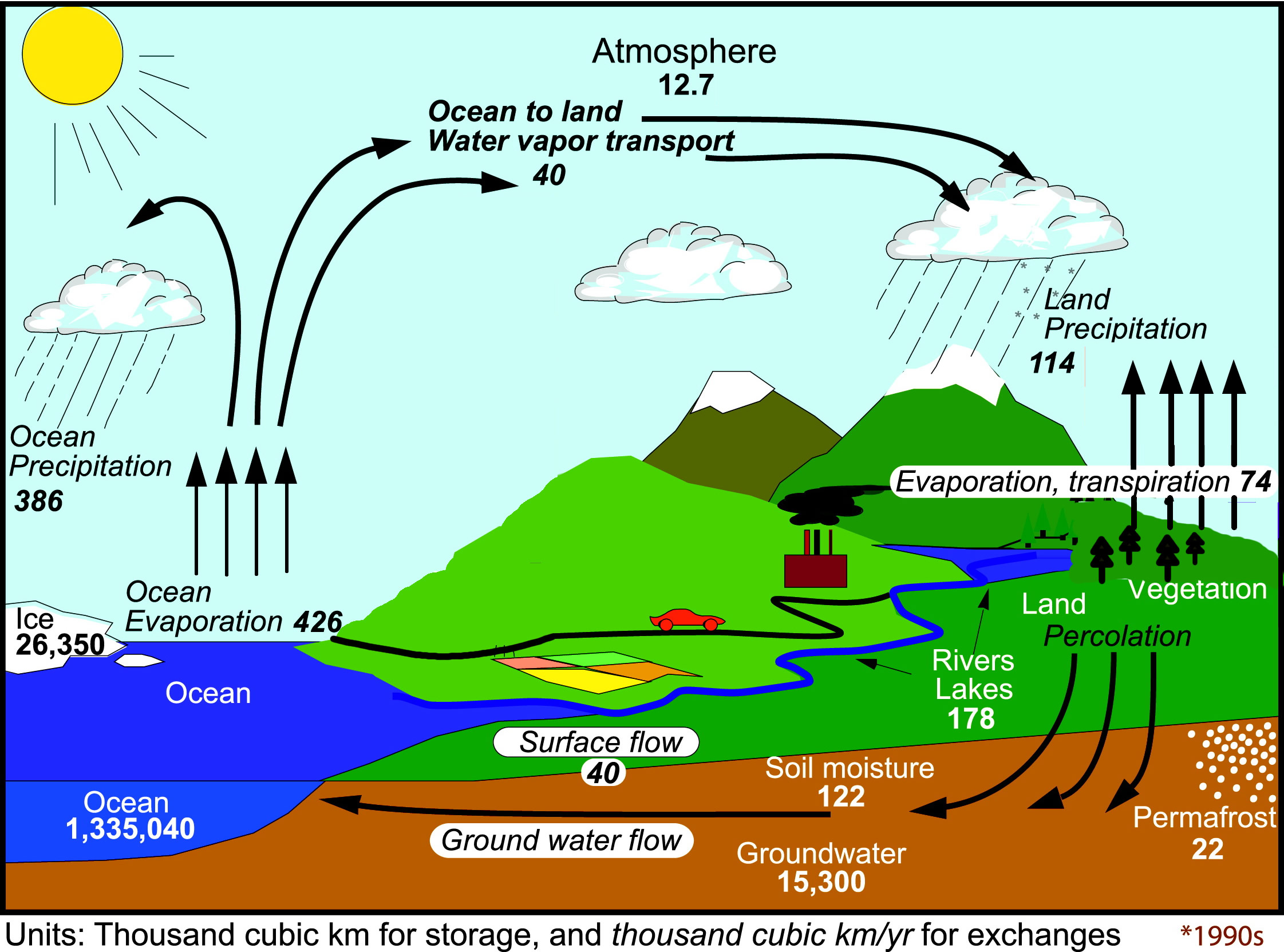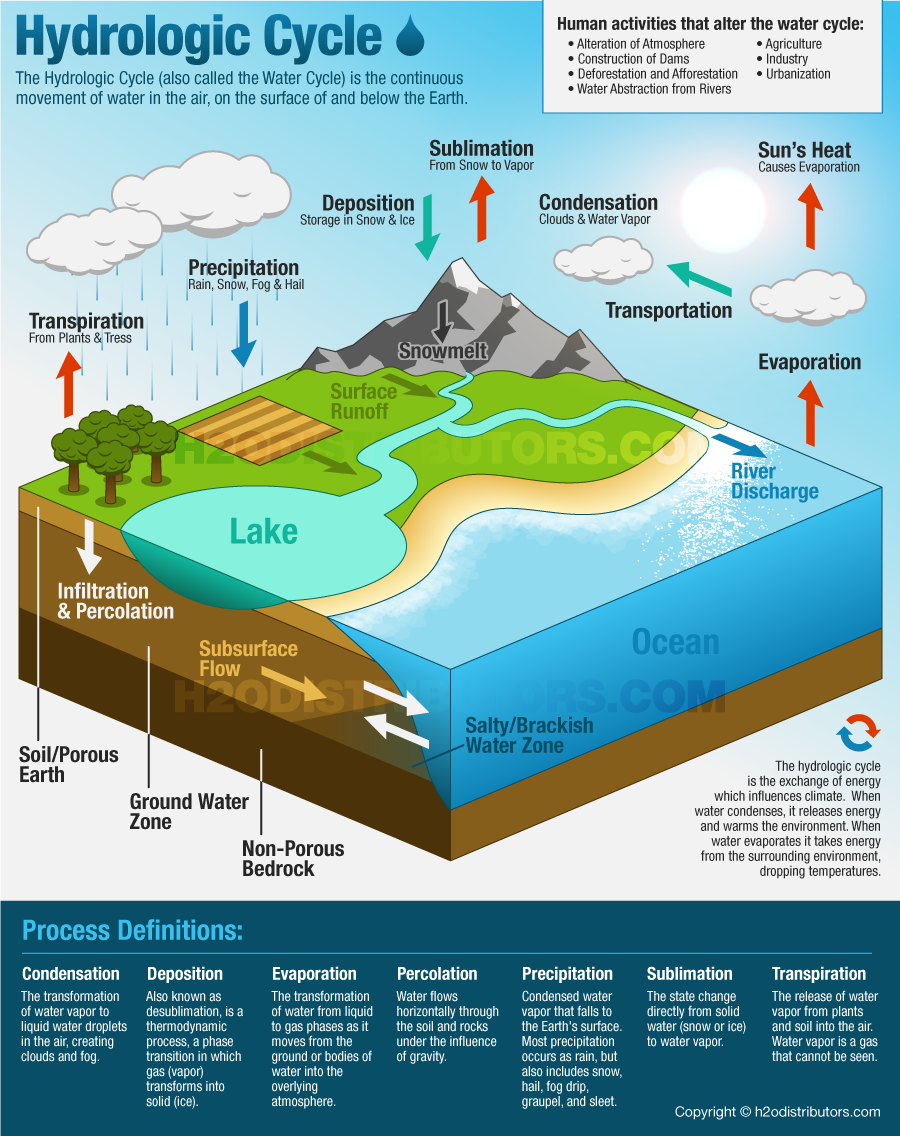- Sự Tuần Hoàn Của Nước (The Water Cycle), hay bấm vào đây.
- Từ vựng về "Water Cycle" (Glossary of Terms)
- EPA's Drinking Water and Ground Water Kids' Stuff
- EPA's Other Kids' Stuff
- Games and Activities
- EPA's Children & Drinking Water Standard [PDF]
- Other page on kids' corner
- Water Conservation Poster Contests
- Kids for Saving Earth
- Arizona Enviro-Kids Canyon!
- Tìm hiểu về Không Khí và Nước
Từ Vựng về Sự Tuần Hoàn của Nước ("Water Cycle" Glossary of Terms)
The water supply of Earth is a required element for life to exist and thrive. The water cycle is a continuous cycle that keeps water moving on and around Earth in different forms. The different stages of the water cycle include evaporation, condensation, precipitation, and collection. Each stage of the cycle leads to the next stage, and each stage is an important part of a process that helps to water plants, fill cisterns, dry up puddles, and remove floodwaters.

Aquifer: An aquifer is an underground layer that contains groundwater.
Atmosphere: A unit of atmosphere measures the air pressure at sea level, which is about 14.7 pounds per square inch.
Climate: The climate of a location includes all of the weather conditions for this location over an extended period of time.
Cloud: A cloud is a visible mass of small water droplets or tiny ice crystals that are suspended in the atmosphere.
Cloud Condensation Nuclei: Water vapor surrounds tiny particles, condensing in clouds to become raindrops.
Condensation: Condensation is the process by which water vapor changes into liquid.
Current: Currents are predictable and steady flows of fluid in a larger body of fluid.
Density: Density describes the amount of things in a specific space.
Dew Point: Dew point is the temperature at which water in the air condenses to become water droplets near the ground.
Ecosystem: An ecosystem is a community of living and nonliving things in an area.
Erosion: Erosion happens when soil is worn away, usually by wind, water, or ice.
Evaporation: Evaporation is the process of water changing into water vapor.
Evapotranspiration: When moisture from the soil evaporates into the atmosphere or when transpiration from plants occurs, this is called evapotranspiration.
Fog: Clouds near the ground are known as fog.
Freshwater: A lake, river, or spring is a source of freshwater, which animals can drink.
Glacier: A glacier is a mass of ice that moves slowly across a land mass.
Great Lakes: The Great Lakes are the biggest freshwater bodies of water in the world, located in the United States.
Greenhouse Gas: Gases in the atmosphere that absorb solar heat reflected by Earth's surface, contributing to warming of the atmosphere, are greenhouse gases.
Groundwater: Groundwater is water found in an aquifer.
Humidity: The amount of water vapor in the air is the humidity.
Ice: Ice is water in solid form.
Ice Cap: An ice cap is an area of less than 19,000 square miles covered by ice.
Ice Sheet: Ice sheets are glacial ice areas that cover a large expanse.
Lake: A lake is a body of water that is surrounded by land.
Microscopic: Microscopic describes something very small.
Pollutant: A pollutant is a substance that harms a natural resource.
Precipitation: Precipitation includes all types of water that fall to Earth.
River: A river is a big stream of fresh water that flows.
Runoff: When fluid overflows from a farm or factory, it's known as runoff.
Snowmelt: Melted water from snow is snowmelt.
Temperature: The level of heat or cold, measured by a thermometer, is temperature.
Transpiration: Water that evaporates from plants is transpiration.
Vapor: Vapor is liquid that is suspended in air.
Water Cycle: Water moves between the land, bodies of water, and atmosphere in a process known as the water cycle.
Weather: Weather describes the state of the atmosphere, and it includes atmospheric pressure, temperature, humidity, cloudiness, precipitation, and wind.
Wind: Wind is air that moves from areas of high pressure to low-pressure zones.

[Updated 05/14/21]
#93
